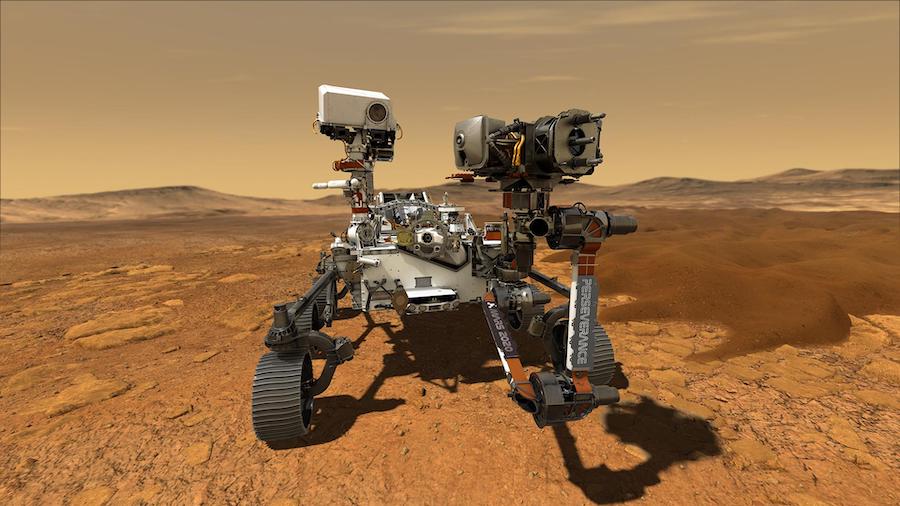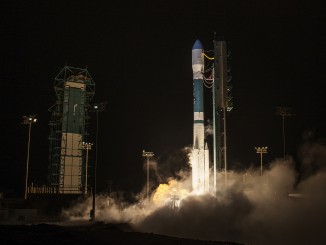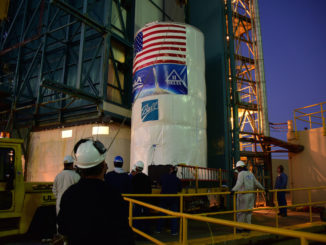
The Perseverance rover’s sterilized sample tubes — designed to seal Martian rock and sediment for eventual return to Earth — are installed on the spacecraft as teams at NASA’s Kennedy Space Center prepare to enclose the rover inside the payload shroud of its Atlas 5 launcher for liftoff July 20.
The addition of 39 super-clean sample tubes, each sterilized in an oven, into the underside of the robotic spacecraft marked one of the final major items to be installed on the Perseverance rover before launch next month. In early July, once the rover is mounted on top of its Atlas 5 rocket, ground crews plan to affix a nuclear battery to the spacecraft that will generate power for years of driving across the surface of Mars.
“We need to make the sample tubes that we take to Mars cleaner than anything that we’ve ever done before in space, and cleaner than almost everything we do here on Earth,” said Adam Steltzner, chief engineer for the NASA’s Mars 2020 mission — of which the Perseverance rover is a part — at the Jet Propulsion Laboratory in Pasadena, California.
“Part of the effort to do that involves us hyper-cleaning the sample tubes in which the samples that we take on Mars will be placed, and then placing them into the rover at last possible minute,” Steltzner said June 10 in a presentation to the National Academies’ Space Studies Board.
Similar in appearance and design to NASA’s Curiosity rover, which landed on Mars in 2012, the Perseverance rover was already attached to its aeroshell when technicians installed the 39 sample tubes May 21. The aeroshell will protect the spacecraft during descent through the Martian atmosphere.
“It’s inside its aeroshell, and just prior to putting the heat shield on and enclosing the vehicle forever, until Mars, we bring these sample tubes and place them into the body of the rover, and put in a protective cover that we will eject once we get to Mars,” Stetlzner said.
Each tube is sheathed in a gold-colored cylindrical enclosure, providing an extra layer of contamination protection. The tubes will ride to Mars inside the housing, and they will be returned to the sheath once filled with Martian rock samples.
The Perseverance rover will carry 43 sample tubes to Mars, including “witness tubes” or blanks, which will allow scientists to cross-check rock and sediment specimens returned to Earth for contamination. The other four tubes were previously loaded into other locations within the rover’s Sample and Caching System.
The tubes are about the size and shape of a slim cigar, and the Perseverance rover will collect core samples on Mars that measure around a half-inch (13 millimeters) wide and 2.4 inches (60 millimeters) long.
“Those samples tubes are part of a Sample and Caching System, which is one of our biggest engineering developments for this mission,” Steltzner said. “We get to Mars largely like the Curiosity rover got to Mars, but we need to do something very different once we’re on Mars. We must take these core samples, seal them hermetically and sterilely, and then produce a cache of samples for eventual return to Earth.”

The Sample Caching System is a complicated piece of equipment, with 17 separate motors, a rotating wheel containing nine drill bits, and 43 tubes to hermetically seal core samples drilled from Martian rocks.
The rover has a 7-foot-long (2-meter) robotic arm with a coring drill on the end. The longer robotic arm will work in concert with a smaller 1.6-foot-long (0.5-meter) robotic manipulator inside the belly of the rover, which will pick up sample tubes for transfer to the main arm for drilling.
Steltzner said the rover’s sampling system actually consists of three different robots.
“Out at the end of our robotic arm — that’s the first robot — is a coring drill that uses rotary percussive action like we have used similarly and previously on Mars with the Curiosity mission, except rather just generating powder, this creates an annular groove in the rock and breaks off a core sample,” Steltzner said.
During each sample collection, the core sample will go directly into the tube attached to the drill.
“That bit and the sample tube are brought back by the robotic arm — our first robot — into the second robot, our bit carousel, which receives the … filled sample tube and delivers it to a very fine and detailed robot, the sample handling arm inside the belly of the beast, in which the sample is then assessed, its volume is measured, images are taken, and it is sealed and placed back into storage for eventually being placed in a cache on the surface.”
The portion of the caching system inside the rover is called the Adaptive Caching Assembly, which consists of more than 3,000 parts alone.
The design of the drill and sample tubes is intended to preserve the distribution minerals cored from Martian rocks. The system is also designed to collect samples directly from softer soils.
The Perseverance rover will target a landing in Jezero Crater on Mars, home to an ancient river delta and lake that scientists believe filled the crater some 3.5 billion to 3.9 billion years ago. Scientists hope to find signatures of ancient life in the rocks and sediments deposited in the dried-up delta.
Steltzner said the rover should be able to fill around 20 of its complement of tubes during a prime mission phase lasting 1 Martian year, or nearly two Earth years. The rover could continue collecting samples from locations farther from its landing site during an extended mission.
Depending on how the mission goes, ground teams could decide to command the rover to drop off the sample tubes at multiple depots along its drive path. Some of the tubes could remain aboard Perseverance to allow the rover to directly load the samples onto a rocket that will land on Mars on a future mission, in case a rover designed to fetch the tubes runs into trouble.
The tubes themselves went through a multi-stage cleaning process, but the sterilization procedures encountered an unexpected roadblock late last year.
Engineers and scientists working with the samples tubes had to meet stringent cleanliness requirements, limiting levels of total organic carbon and other “marker compounds” on the metal canisters, according to Ken Farley, project scientist for the Perseverance rover at JPL.
“Basically, we have to ensure absolute sterility,” Farley said during a presentation in April to NASA’s Mars Exploration Program Analysis Group.

The rover’s development team originally planned to bake the sample tubes to a temperature of 662 degrees Fahrenheit, or 350 degrees Celsius, to eliminate trace amounts of organic material from the cylinders.
“That 350-degree (Celsius) combustion step actually led to unexpected, and actually unacceptable, consequences with respect to friction,” Farley said. “Sliding surfaces were not able to slide as freely as was necessary, and that was causing the tubes or the seals to bind, and not be able to be manipulated properly. So we had to make a change to the plan.
“350-degree (Celsius) baking in air burns everything,” he said. “It is a wonderful way to clean things. We had to get rid of that and reduce it to 150 degrees (302 degrees Fahrenheit).”
The tubes were baked at that temperature for 24 hours, long enough to guarantee the mission met requirements for biological contamination.
To compensate for the lower temperature, teams at JPL rinsed the tubes with multiple solvents and applied ultrasonic energy to enhance the cleaning process, Farley said.
According to Farley, the mission is on track to meet a requirement that the level of certain organic compounds inside the tubes remain less than 1 part per billion.
“The tube is not simply a little hollow cylinder,” Farley said.
Once they met NASA’s requirements, the tubes were shipped across the country from JPL to the Kennedy Space Center in May for installation into the Perseverance rover.
The sample collection system is flying to Mars on the Perseverance rover along with a new suite of science instruments, an upgraded zoom-capable camera, and the first helicopter drone to fly to another planet.
“The mission objectives of our effort are to explore the geology of our landing site, to look for signs of biosignatures from the past,” Steltzner said. “We are not a life detection mission. We are looking for signs of past life on the surface of Mars.
“Also, (we’re looking for) signatures that Mars was habitable, and to the degree that it is still habitable, where it might be habitable,” he said. “Our third objective is to prepare a returnable cache of samples, and then fourth to prepare for future human exploration. We are taking an experiment with us that will produce oxygen, like humans breathe, from the CO2 (carbon dioxide) atmosphere on Mars, using just electricity.”
NASA and the European Space Agency are designing a complex robotic mission to go to Mars and retrieve the samples collected by Perseverance. If technical and funding elements line up just right, the mission could depart Earth in 2026 with a pair of rocket launches from Cape Canaveral and the European launch base in French Guiana.
If that happens, the samples could be back on Earth in 2031.
NASA and ESA will send a stationary landing platform to Jezero Crater — near Perseverance’s landing site — with the Mars Ascent Vehicle, a rocket that will shoot the samples off the surface of the Red Planet and back into space. There will also be a mobile robot to fetch soil samples collected by the Perseverance rover, and an Earth Return Orbiter to bring the specimens back home.
Read more about the Mars Sample Return campaign in our story published earlier this year.

With the sample tubes inserted into the rover last month, teams at the Kennedy Space Center began buttoning up the spacecraft into its launch configuration. After closing up the rover inside its heat shield, teams planned to mount the vehicle on a cruise stage that will carry the rover from Earth to Mars and fine-tune the spacecraft’s trajectory before entering the Martian atmosphere.
Beginning as soon as Thursday, workers inside the Payload Hazardous Servicing Facility will begin encapsulating the spacecraft inside the payload fairing of the Atlas 5 rocket that will launch the rover.
If all goes according to plan, the spacecraft should be closed up within the Atlas 5’s bulbous white payload shroud by next Monday, June 22. The rover will be transported June 26 from the Payload Hazardous Servicing Facility at the Kennedy Space Center to United Launch Alliance’s nearby Vertical Integration Facility at Cape Canaveral Air Force Station, according to Mary MacLaughlin, a NASA spokesperson.
Once at the VIF, the spacecraft and its protective launch fairing will be raised on top of a ULA Atlas 5 rocket.
Before the rover is ready to meet the rocket, ULA crews plan to roll the nearly-complete Atlas 5 rocket from its vertical hangar to pad 41 for a countdown rehearsal June 22. During the practice session, ULA will fill the Atlas 5 with kerosene, liquid hydrogen and liquid oxygen propellants to run the rocket through a full checkout before launch day.
ULA performs the full-up “wet dress rehearsals” before missions with limited planetary launch windows.
The Atlas 5 will be returned to the VIF for the arrival of the Perseverance rover.
One of the final tasks to ready the rover for launch will be the installation of a plutonium-fueled nuclear power generator on the spacecraft. That will occur once the rover is already fastened on top of the Atlas 5 rocket inside ULA’s vertical hangar.
Technicians will enter through an access door on the Atlas 5’s payload fairing, then place the power source on Perseverance through an opening on the spacecraft’s backshell, which encloses the rover and its landing system during the journey from Earth to Mars.
Ground teams finished stacking the Atlas 5 rocket on its mobile launch platform inside the VIF earlier this month after overcoming a problem with a crane that forced officials to delay the Perseverance rover launch date from July 17 to July 20.
There’s a two-hour launch window available July 20 opening at 9:15 a.m. EDT (1315 GMT), according to NASA.
The mission must launch during a 26-day launch window spanning from July 17 through Aug. 11 to enable the robotic spacecraft to travel directly on a seven-month journey from Earth to Mars.
The rover is scheduled to arrive at Mars on Feb. 18, 2021, using the same sky crane descent technique pioneered by NASA’s Curiosity rover in 2012. But Perseverance will debut several new capabilities, including a more precise landing navigation system aimed at narrowing the rover’s landing zone.
NASA announced the name Perseverance for the Mars 2020 rover in March, shortly before the coronavirus pandemic changed lives around the world.
The space agency has prioritized work on the rover amid restrictions intended to slow the spread of COVID-19, using NASA airplanes to shuttle essential engineers to and from the Kennedy Space Center to work on the spacecraft. NASA required most of the rover team, including scientists, to work remotely.
“Her name could not have been more important for the moment we find ourselves,” Steltzner said. “Her name is Perseverance, and it is my hope that she does and will continue to stand as a beacon for perseverance, one of the human attributes that we are going to have to hold most firmly for the next period of time.”
Email the author.
Follow Stephen Clark on Twitter: @StephenClark1.



